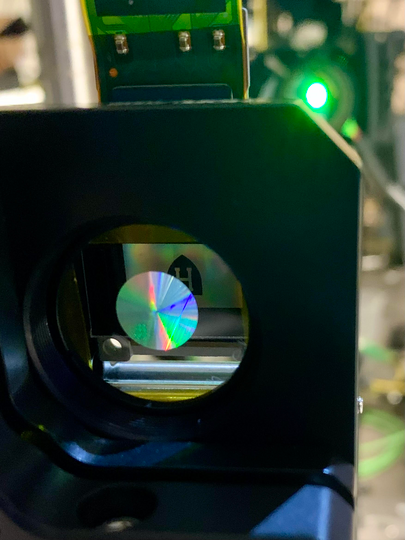Metasurfaces are a potential technology for wearable electronics, especially virtual and augmented reality systems, since they use carefully designed and structured nanostructures on a flat surface to target, shape, and manipulate light.
 The fabricated metalens together with a micro-LCD display showing a Harvard logo. Image Credit: Capasso Lab/Harvard SEAS.
The fabricated metalens together with a micro-LCD display showing a Harvard logo. Image Credit: Capasso Lab/Harvard SEAS.
Currently, research teams methodically create the exact arrangement of nanostructures on the lens’ surface to fulfill the intended functions of the lens, whether it is resolving nanoscale features, concurrently producing many depth-perceiving images, or centering light regardless of polarization.
If metalens is to be used professionally in AR and VR systems, it will need to be greatly scaled up, which implies billions of nanopillars would be required. Artificial intelligence can help scientists create something like this.
A group of researchers from the Harvard John A. Paulson School of Engineering and Applied Sciences (SEAS) and the Massachusetts Institute of Technology (MIT) presented a novel framework for developing large-scale metasurfaces that utilize machine intelligence methods to create designs instantaneously. The study was published in Nature Communications.
This article lays the groundwork and design approach which may influence many real-world devices. Our methods will enable new metasurface designs that can make an impact on virtual or augmented reality, self-driving cars, and machine vision for embarked systems and satellites.
Federico Capasso, Study Senior Author and Robert L. Wallace Professor, Applied Physics, Harvard John A. Paulson School of Engineering and Applied Sciences
Capasso was also a Vinton Hayes Senior Research Fellow in Electrical Engineering at SEAS.
Until now, creating a metasurface required years of expertise and industry experience.
We’ve been guided by intuition-based design, relying heavily on one’s training in physics, which has been limited in the number of parameters that can be considered simultaneously, bounded as we are by human working memory capacity.
Zhaoyi Li, Study Co-Lead Author and Research Associate, Harvard John A. Paulson School of Engineering and Applied Sciences
To overcome these restrictions, the team introduced the physics of metasurface structure to a computer program. The application generates metasurface designs autonomously, with millions to billions of parameters being designed at the same time.
This is an inverse design approach, which means the scientists start with the desired function of the metalens — such as a lens that corrects chromatic aberration — and the computer uses its computational techniques to determine the optimum design geometries to achieve that aim.
Letting a computer make a decision is inherently scary but we have demonstrated that our program can act as a compass, pointing the way to the optimal design. What is more, the whole design process takes less than a day using a single-CPU laptop, compared with the previous approach, which would take months to simulate a single metasurface of 1 cm diameter working in the visible spectrum of light.
Raphaël Pestourie, Study Co-Lead Author and Postdoctoral Associate, Massachusetts Institute of Technology
“This is an order-of-magnitude increase in the scale of inverse design for nanostructured photonic devices, generating devices tens of thousands of wavelengths in diameter compared to hundreds in previous works, and it opens up new classes of applications for computational discovery,” added Steven G. Johnson Professor of Applied Mathematics and Physics at MIT and study co-corresponding author.
The research group, based on the new research, designed and created a centimeter-scale, polarization-insensitive, RGB-achromatic meta-eyepiece for a virtual reality (VR) platform..
Li further concluded by stating, “Our presented VR platform is based on a meta-eyepiece and a laser back-illuminated micro-LCD, which offers many desirable features, including compactness, lightweight high resolution, wide color gamut, and more. We believe the metasurface, a form of flat optics, opens a new path to reshape the future of VR.”
Journal Reference:
Li, Z., et al. (2022) Inverse design enables large-scale high-performance meta-optics reshaping virtual reality. Nature Communications. doi.org/10.1038/s41467-022-29973-3.